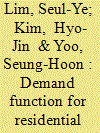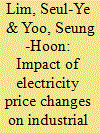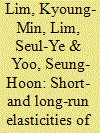| Srl | Item |
| 1 |
ID:
150027


|
|
|
|
|
| Summary/Abstract |
The demand for residential heat (RH) through a district heating system (DHS) has been and will be expanded in Korea due to its better performance in energy efficiency and the abatement of greenhouse gas emissions than decentralized boilers. The purposes of this paper are two-fold. The first is to obtain the demand function for DHS-based RH in Korea and investigate the price and income elasticities of the demand employing the quarterly data covering the period 1988–2013. The short-run price and income elasticities are estimated as −0.700 and 0.918, respectively. Moreover, the long-run elasticities are −1.253 and 1.642, respectively. The second purpose is to measure the consumption benefits of DHS-based-RH employing the economic theory that they are the sum of the actual payment and consumer surplus for the consumption. Considering that the average price and estimated consumer surplus of the DHS-based RH use in 2013 are computed to be KRW 87,870 (USD 84.1) and KRW 62,764 (USD 60.1) per Gcal, the consumption benefits of the DHS-based RH are calculated to be KRW 150,634 (USD 144.2) per Gcal. This information can be beneficially utilized to conduct an economic feasibility study for a new DHS project related to RH supply.
|
|
|
|
|
|
|
|
|
|
|
|
|
|
|
|
| 2 |
ID:
125684


|
|
|
|
|
| Publication |
2013.
|
| Summary/Abstract |
Electricity has played an important role in the economic development of Korea and, thus, has become a critical factor in sustaining the well-being of the Korean people. This study attempts to investigate the impact of electricity price changes on industrial prices and the general price level using input-output (I-O) analysis. To this end, we apply the I-O price model to the 2011 I-O table recently produced by the Bank of Korea, paying particular attention to the electricity sector by considering it as exogenous and then investigating its impacts. The impacts of the electricity price changes on each industrial sector's prices and the general price level are quantitatively derived. For example, the overall impact of a 10% increase in electricity price on the Korean national economy is estimated to be 0.4367%. We also report the results from the model with the electricity sector endogenous and the model with endogenous electricity and labor sectors. This information can be usefully utilized in decision-making regarding price management for electricity.
|
|
|
|
|
|
|
|
|
|
|
|
|
|
|
|
| 3 |
ID:
128383


|
|
|
|
|
| Publication |
2014.
|
| Summary/Abstract |
This paper attempts to examine the electricity demand function in the Korean service sector using the annual data covering the period 1970-2011. The short- and long-run elasticities of electricity demand with respect to price and income are empirically estimated using a co-integration and error-correction model. The short- and long-run price elasticities are estimated to be -0.421 and -1.002, respectively. The short- and long-run income elasticities are computed to be 0.855 and 1.090, respectively. Electricity demand in the service sector is inelastic to changes in both price and income in the short-run, but elastic in the long-run. Therefore, it appears that a pricing policy is more effective than the direct regulation of reducing electricity demand in the long-run in order to stabilize the electricity demand in the service sector. Moreover, it is necessary to encourage a more efficient use of electricity to cope with increasing demand for electricity following economic growth because the electricity demand in the service sector is income-elastic in the long-run.
|
|
|
|
|
|
|
|
|
|
|
|
|
|
|
|